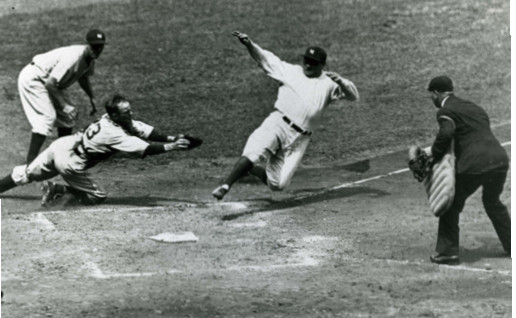Babe Ruth Stealing Home
This article was written by Bill Nowlin
This article was published in The Babe (2019)

Babe Ruth slides into home plate. (Library of Congress.)
Stealing home plate during a baseball game is one of the most exciting plays in the sport. Sometimes a steal of home is part of a double steal, and sometimes just a straight steal. It is always unexpected; that’s the only way it can work – the pitcher has to be caught unprepared for the possibility. Even with thousands of fans watching the game at a ballpark, very few will likely be watching a baserunner on third base and anticipating that he might attempt to steal home. Umpires, of course, have to be mindful of the possibility.
It is something of a lost art today but was more frequent in days gone by. Ty Cobb is said to have stolen home 54 times, often as part of a double steal. In 1912 alone, he supposedly stole home eight times. A player has stolen home twice in the same game a reported 11 times.1 One of the most famous steals of home was that executed by Jackie Robinson in Game One of the 1955 World Series against the Yankees.2
Some noted basestealers were not known for stealing home. Lou Brock never once stole home, and Rickey Henderson did it only four times. But Babe Ruth reportedly did it 10 times.
You look at old film of The Babe and he comes across as almost the last person you’d expect to see steal any base – second, third, or home. But he is credited with 123 stolen bases over the course of his career. He stole 10 or more bases in a season five times, including in 1930 when he was 35 years old. Ruth even stole second and then third in Game Two of the 1921 World Series.
When did he steal home these 10 times?
It’s difficult to pin down data on stolen bases, particularly when ranging back a century or so. One author observed, generally: “The data on stolen bases are a mess. The American League didn’t start reliably keeping caught-stealing records until 1920, and the National League not until 1951, thus eliminating a very large number of contenders from our consideration and forcing careful examination of many of the rest.”3
Retrosheet, in its list of discrepancies regarding Babe Ruth’s record, reflects a stolen base in the first game of April 19, 1928, which is not in the official record. Perhaps Ruth actually had a total of 124 stolen bases? In the course of my research for this article, I discovered what appear to be two stolen bases he was credited with (both from the same game, on May 5, 1920) that may be questionable.4 I reached out to Retrosheet and asked about these two stolen bases. They had independently come across the same question, and added the two to their list of Babe Ruth discrepancies, to be posted the next time they do an update (which will probably have been done by the time this article appears). Perhaps this all adds up to 122 stolen bases.
Searching for Ruth steals of home plate, I looked up every game in which he was said to have stolen any base – all 124 of them (I looked up the April 19, 1928, one, too), plus four postseason steals. It was easy to rule out many of them as steals of home. Sometimes a newspaper account would straightforwardly report that Ruth had stolen second base. OK, that one gets ruled out. Sometimes he stole a base, but it wasn’t clear which base – and yet, since he wasn’t credited with a run scored, I tended to think that that probably wasn’t a game in which he stole home!5 When the Yankees were shut out, 1-0, on July 28, 1920, we know his stolen base was not a steal of home. Other times, Ruth had one run scored but his home run in that game clearly accounted for the run scored. In the second game on August 15, 1926, the Yankees scored three times and three different Yankees had runs batted in – so we can account for each run. His steal had to have been of second or third.
I was able to rule out a considerable number of games through this approach. Based on contemporary newspaper accounts, I did find the eight steals of home noted here:
August 24, 1918 – Ruth was the starting pitcher against the visiting St. Louis Browns. He won a complete-game 3-1 victory. His steal was the run that made the difference, in a three-run bottom of the second. The next day’s Boston Globe subhead read: “Ruth Rubs It In, Stealing Home with Third Run.”
June 4, 1920 – The Athletics played the Yankees at the Polo Grounds. In the fourth inning, Ruth doubled off the right-field wall, advanced to third on Del Pratt’s single along the third-base line, and then the two of them “tried the double steal with such success that Ruth slid in with the run.” (June 5 New York Daily Tribune)
July 20, 1921 – In Cleveland, the New York Herald wrote, “Ruth and (Frank) Baker flashed a double steal in the third which quite discomfited the home folks.”
July 28, 1924 – In the top of the fifth inning, in the second game of two at Comiskey Park, Ruth “drew a pass and scored in a double steal with (Bob) Meusel.” (Chicago Tribune) Ruth had scampered first to third on Meusel’s single, then stole home with the 11th run of an eventual 12-10 Yankees win.
September 2, 1924 – With a runner on second and one out in the first inning of the second game of a doubleheader in New York, Ruth was intentionally walked. Wally Pipp singled, driving in the lead runner with Ruth taking third. After Wally Schang fouled out, “Ruth and Pipp then successfully executed a double steal.” (Boston Globe) Meusel then singled Pipp across. The three runs were all they needed to beat the Babe’s former team, the Red Sox.
July 22, 1926 – In this game, Ruth tried to steal home twice. At Yankee Stadium, against the visiting White Sox, Retrosheet reports that he was caught the first time but succeeded the second. The Chicago Daily News shows Ruth caught stealing in the bottom of the first inning. In the bottom of the sixth, Ruth had reached base on a force play that retired Lou Gehrig. He took third base on Ben Paschal’s single. Paschal then stole second. As Mike Gazella took ball four, both Ruth and Paschal were in motion and were each credited with steals of home and third, respectively. The Chicago Tribune wrote that Ruth “stole home, drawing a wild pitch from the pitcher.” The pitch was wild enough that Paschal ran around third and scored, too.
June 9, 1927 – Facing relief pitcher Bert Cole, with the Yankees leading 7-3 over Chicago, Ruth tripled over the left fielder’s head in the bottom of the eighth. Then Lou Gehrig struck out. Ruth apparently decided to take action. The New York Times wrote, “At the first opportunity, the Big Bam lit out for home. Mr. Cole was so unnerved by this unexpected manoeuvre that he threw the ball past his catcher.”
July 27, 1931 – Ruth hadn’t stolen home in more than four years, but once again the White Sox were the victims. In the bottom of the first, in the second game of a doubleheader, Ben Chapman stole second while Ruth came home on a double steal. Four of the eight listed steals of home were against the White Sox.
As with all baseball statistics, even those almost a century old, there remains the possibility that another researcher will turn up another steal of home, or two, or more. I would welcome hearing information on the subject. Until such time, I feel reasonably confident that Ruth can be credited with eight steals of home plate – which is pretty impressive.
BILL NOWLIN was elected as SABR’s Vice President in 2004 and re-elected for five more terms before stepping down in 2016, when he was elected as a Director. He has specialized in Red Sox research since he turned to writing and research in the late 1990s and has written, edited, or co-edited more than 75 books and more than 750 articles, many of which are Red Sox-related. He is one of three founders of Rounder Records, one of America’s most successful independent record labels. A member of the International Bluegrass Music Hall of Fame, he has also traveled widely, visiting more than 125 countries to date, and has occasionally taught courses at Boston-area universities on “Baseball and Politics” and Sportswriting. He was the 2011 winner of the Bob Davids Award, SABR’s highest honor. He lives in Cambridge, Massachusetts.
Notes
1 baseball-almanac.com/recbooks/rb_stbah.shtml. This page also provides data on the 38 players who have stolen home 10 or more times in the course of their careers. The only player in the last 50 years to have done so is not a name most would have guessed: Paul Molitor. A note of acknowledgement to Stephen Boren – thanks for encouraging me in my work on this subject.
2 Highlights of the Series, including film of Robinson’s steal, may be seen at youtube.com/watch?v=k4EUXTbbsAg. One of the most famous attempted postseason steals was one Babe Ruth failed to execute – in Game Seven of the 1926 World Series, with two outs and the Cardinals leading, 3-2, Ruth was caught trying to steal second base in the bottom of the ninth inning. The game was over, and the World Series was thus over as well. He had stolen second successfully in Game Six. Trying to steal another in the very next game may not have been the wisest decision. Newspaper coverage indicates that he was the one who chose to make the attempt.
3 Mississippi Matt Smith, “Babe Ruth Was the Worst Base Stealer of All Time,” at not.fangraphs.com/babe-ruth-was-the-worst-base-stealer-of-all-time/. For a contrary view, see Zachary D. Rymer, “Stealing Home: Or, Why Babe Ruth Is a Better Thief Than Rickey Henderson,” BleacherReport.com, August 6, 2010 at bleacherreport.com/articles/430984-stealing-home-or-why-babe-ruth-is-a-better-thief-than-rickey-henderson#slide9.
4 The official records indicated two steals for Ruth in this game. Neither the New York Times, New York Daily News, nor Philadelphia Inquirer reports him stealing any bases. The Washington Herald says he stole one. The Washington Post says two. But they aren’t noted in the game story. There was a play in which he scored from second base, taking third base and then home on a passed ball. Ruth had been on second and Duffy Lewis on first. After the ball got away from the catcher, Val Picinich, the Post’s game story said, “Ruth and Lewis broke from their base moorings, but thought better of it. Picinich threw to Judge to get Lewis straggling back to first. As he did so Ruth broke for third, rounded it and watched the Griffs run Lewis up and down between second and third. Finally Babe darted for home, having been allowed too long a lead, and he beat [Frank] Ellerbe’s throw.”
5 The April 19, 1928, game was at Fenway Park. The steal is reported in the Boston Herald box score, but Ruth did not have a run scored in the game. Hence, the Herald did not see it as a steal of home. The Boston Globe box score was identical in this respect. I went day by day through such newspapers as I could access.


